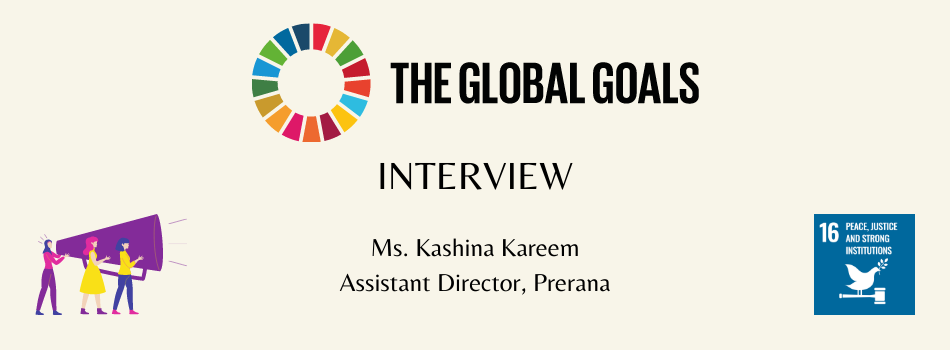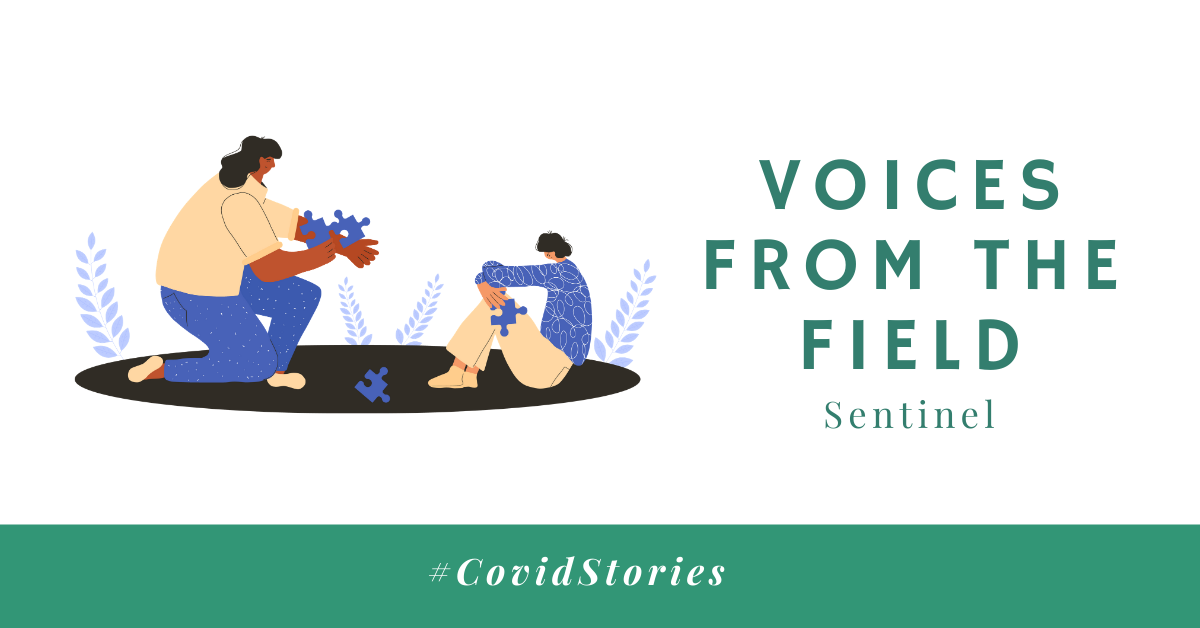
SDG Goal 16: Navigating through Prerana's Anti-Human Trafficking Interventions
Shatakshi Saxena
Project Coordinator (Documentation and Communications)
Ms. Kashina Kareem has been associated with Prerana for more than 5 and a half years. She is currently working under the anti trafficking center, heading the post rescue operations project. Among other things at Prerana, she works with a team that provides on field support to both state and non state stakeholders working with victims of commercial sexual exploitation and trafficking.
Prerana has been working to end intergenerational trafficking in the red-light areas of Mumbai for over three decades. What has been Prerana’s approach, and the challenges encountered while working with women in the sex trade and their children?
Prerana started its work in the red-light areas more than 3 decades ago upon noticing the plight and unfulfilled needs of the children residing there. The major concerns back then were to ensure the safety and security of children especially during the night hours and their access to developmental opportunities. Prerana thus initiated interventions to plug those gaps and to address those needs. The Night Care Center, Prerana’s flagship program provided a safety net for children during the night when they were the most vulnerable in the redlight areas (RLAs). Over a period of time, this center became a space that provided the necessary nourishment to the children who belonged to malnourished/ marginalized backgrounds. Back in the day, children born to the women in the sex trade had limited or no educational opportunities. Prerana thus began not only admitting the children in schools but also following up on their education, addressing challenges they face in the school and involving/engaging their mothers in the process of the child’s progress. The aim was to retain the child in the formal educational system and help them cross the educational milestones. This was a Herculean task mainly due to a strong stigma and social discrimination in the society against these women and their children.
Given Prerana’s experience in working with minor victims of commercial sexual exploitation (CSE) and child victims of sexual exploitation, what are the models of care that should be followed to ensure the safe rehabilitation of children?
Prerana has worked with minor victims rescued from commercial sexual exploitation (CSE) for over two decades now and we have witnessed the system and processes evolve. We have successfully been able to fight for the right of these individuals to be seen as victims and not as those who are violating the law. Besides, civil society organizations with support from the government bodies have worked relentlessly to rehabilitate the victims who have been rescued from the sex trade. Even though the task of rehabilitation is tough, there are quite a few success stories over the past few years that are worth mainstreaming and to help derive learnings from. In Prerana’s experience, we have identified three primary care models for minor victims who have been rescued from the sex trade. First is the conventional institution based rehabilitation model where an individual gets the opportunities for development while residing in a Children’s Home. Lately, this model is losing its importance, considering the challenges that entail when an institutionalized child is socially reintegrated into the society. Prime importance is being apportioned to exploring options for socialization when children are living under institutional care, that would further their eventual social reintegration.
The second care model is the restoration and family strengthening model where children may be restored to their families, if it is safe and in their best interest. There may be some interventions that may be necessary for the child’s successful rehabilitation with the family post restoration. Thus, this may involve regular interaction with the child protection system through an NGO or government child protection functionaries. The third model is the aftercare model for those who need support and assistance from the child protection system even after they turn 18 due to various reasons – they may have been rescued only at 16 or 17 and thus have interacted and taken advantage of the child protection system only briefly, lack of social support systems, family unwilling to take the responsibility of the young adult, etc. These models are quite interdependent and are essentially to offer the continuum of care services to children and young adults who have been victims of sexual violence.
What initiatives has Prerana taken towards capacity building and training for various stakeholders involved in the process of rehabilitation of children in need of care and protection?
While working on the rehabilitation of children rescued from the sex trade and those needing care and protection, Prerana has evolved an understanding on the gaps within the child protection system. This observation is based on our field experiences. At Prerana, we often try to discuss and plug these gaps through capacity building programs and sensitization trainings for various stakeholders working within the child protection system. No victim can be healed by giving some inputs to the victim alone. A lot of work has to be done with the victim’s environment, the public administration as well as social forces. Prerana did pioneering work in sensitizing, training and building capacities of a wide range of duty bearers, caregivers, stakeholders like police, prosecution, judiciaries, Child Welfare Committees (CWCs)s, Probation Officers, CCI staff, lawyers, ChildLine, CSOs, INGOs, public transport drivers and conductors, railway motormen, media, elected representatives, auto rickshaw drivers, corporate officers etc. Special efforts were made to build the capacities of the CCI staff and the caregivers and duty bearers in order to provide effective victim assistance and rehabilitation services.
Prerana has worked relentlessly to create a better and more evolved understanding of the Juvenile Justice (Care and Protection of Children) Act, 2015 and the provisions and tools therein like the Social Investigation Report (SIR) and Individual Care Plan (ICP) to further rehabilitation of the children in need of care and protection. In terms of sensitization programs, Prerana has positively contributed towards developing a better understanding of the crime of human trafficking, especially trafficking for CSE, intergenerational trafficking, the interface of the crime of CSE with the POCSO Act 2012, etc.
The pandemic has pushed children out of the safety net, and increased the risk of exploitation. What challenges did Prerana face while working with children and their families during these trying times?
Prerana is a civil society organization strongly rooted in the field. Due to the pandemic and the resultant lockdown and restrictions on traveling, movement and gatherings, Prerana faced innumerable challenges in reaching out to the children, families and communities we work with. There were limited means both in terms of human resources and financial resources at least during the beginning of the pandemic. Most of the children and families that Prerana’s various projects work with and adults were out of jobs and some of them continue to bear the brunt of the pandemic on their livelihood and income. Savings, even though they were meagre, were exhausted and the pandemic pushed some of the women and other marginalized families to lend money to meet their basic needs.
From April 2020 until very recently in August 2021, Prerana extended ration and basic hygiene material support to women and other vulnerable families that we work with. A bigger challenge during the pandemic was concerning the development of children belonging to marginalized backgrounds. Most of the children we work with struggled to access online education considering the digital divide and the innumerable challenges with technology. The teams that worked with victims rescued from the sex trade were facing challenges concerning the rehabilitation of the victims. Educational and vocational training programs were on a standstill for a considerable period of time. Legal processes in courts were also being adjourned. Those children who were restored only recently, faced challenges in continuing on their path of rehabilitation and with limited access to reach out to the child protection system, the possibility of re-trafficking due to enhanced vulnerabilities emerged. Collaboration and networking with various stakeholders including government and civil society proved to be helpful in addressing some of these challenges.
How have the anti- human trafficking laws in India evolved over the past few decades to protect children? Are there any gaps that can be addressed to ensure the fulfilment of Goal 16?
The principal criminal law of India namely the Indian Penal Code was codified in 1860 by the British colonial rulers. It has since been amended several times and the last significant amendment was in 2013. It elaborated the offence of rape (Sec 375/376) and added the definition of human trafficking in the law in Sec 370. There were laws against the trafficking of minor girls in prostitution in the name of dedication to Gods and temples or in the name of social customs. The (1947) law against Devadasi system or the U.P. Naik Girls Act 1929 are some examples. In the post-independence India there were state laws in some states for rehabilitation of the Devadasis giving them pension and starting hostels for their children. In 2012, Protection of Children from Sexual Offences Act 2012 (POCSOA) addressing a variety of sexual offences against children was passed. It covered substantial offences commonly committed against children under the sex trade and sex trafficking.
The first law Immoral Traffic (Prevention) Act specifically against sex trade was passed in 1956 and was effectively revised in 1986 and is still sought to be amended. The ITPA is an exceptionally progressive law which asserts the prostituted woman as victim of sexual exploitation and penalizes organized sex trade. It considers prostitution as essentially commercial sexual exploitation. An attempt was made by the Union government to come up with a new law claiming to be a single omnibus law to comprehensively address human trafficking. It got aborted on technical grounds. There is need for a law that can address a number of destinations of human trafficking such as trafficking for organ trade, mail bride, contract marriages, illegal adoption, supply chain trafficking etc. However, the existing legal framework against sexual offences, CSEC and sex trafficking is quite good and needs only minor revisions. What is actually needed is its effective implementation.
This is the fourth interview in the ten-month long series on Prerana’s commitment to sustainable development goals. Watch this space for more.
To be or not to be? Questions on motherhood searching answers
Neema (name changed) is a 15-year-old child, who entered the juvenile justice system in 2019, as a child in need Read more
Ms. Azra Qaisar is the Documentation and Communications Manager at Prerana. She is working with the Anti-Trafficking Center in developing Read more



